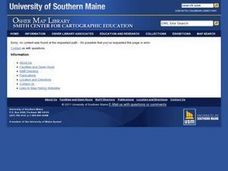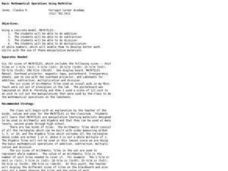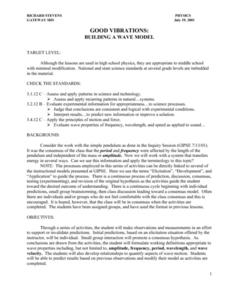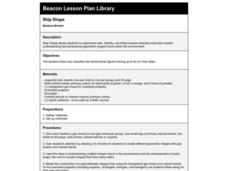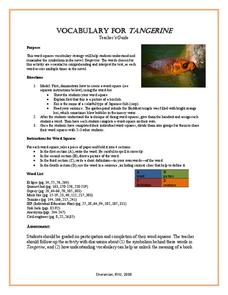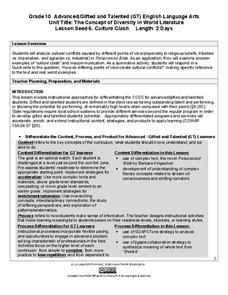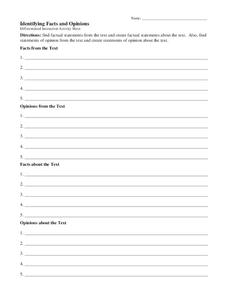Curated OER
Dr. Jekyll and Mr. Hyde: Request Strategy
Model for readers how to develop effective questions with a request strategy for questioning. Text-explicit, text-implicit, and experiential based questions are the focus. Step-by-step instructions are included for the strategy that...
Curated OER
Charting Neptune's Realm: Profiles
Students identify and describe the importance of nautical profiles in early navigation. They draw a profile of a street or mall and explore the effectiveness of different types of directions.
Curated OER
Snow Goggles
Pupils assemble snow goggle models and discuss how snow goggles change the amount of light shining in their eyes.
Curated OER
What is the Rock Cycle and Its Processes?
Geology beginners examine three different rock samples and determine their origin by their characteristics. By making and recording observations, they become familiar with features of igneous, metamorphic, and sedimentary rock types....
Curated OER
Basic Mathematical Operations Using Math Tiles
Practice addition, subtraction, multiplication, and division using tiles as manipulatives. In this math operations lesson, young learners choose the appropriate sized tiles, arrange them according to directions given by the teacher, and...
Curated OER
Analyzing Literature via Literature Circles
Introduce literature circles with Roland Smith's novels. Your seventh graders will see the activity modeled as you read The Three Little Pigs together and apply the format to a Roland Smith novel of their choice. The lesson includes...
Curated OER
Definition Poems
“Hope is a tissue, wiping away your problems and fears.” Use a Definition Poem Web worksheet to model for your class how to craft a free verse poem based on an emotion. After brainstorming topics, groups use the sheet to make comparisons...
Curated OER
Good Vibrations: Building a Wave Model
Young scholars assess and apply recurring patterns in natural systems. They evaluate the wave properties of frequency, wavelength, and speed as applied to sound. Students develop a relationship to quantify aspects of wave motion. They...
Curated OER
Properties of Multiplication
Fifth graders examine the process of multiplication and the relationship between addition and multiplication. They observe the teacher model a variety of problems on the board, and identify properties of multiplication. Students...
Curated OER
ARTSEDGE: Creating Costumes
Young designers examine famous monarch portraits and costume books, create a design for the emperor, examine fabric samples and choose a type and color for their costume. They sketch the costume and present it in a class fashion show.
Curated OER
Mean, Median, and Mode
Seventh graders examine the uses of mean, median, and mode. They define key vocabulary terms, observe the teacher model examples of mean, median, and mode, and discuss real world examples of central tendency of sets of data. Students...
Curated OER
Ship Shape
Third graders experiment with, identify, and follow teacher-directed instruction toward understanding two-dimensional geometric shapes found within the environment. Groups of students utilize geoboards to help them explain geometric shapes.
Curated OER
Polyhedra: Faces, Edges, and Vertices (3-D Marshmallow Models)
Third graders explore the attributes of 3-dimensional shapes. In this shapes lesson plan, 3rd graders examine faces, edges, and vertices of 3-dimensional shapes as they construct shapes using marshmallows and toothpicks.
Curated OER
Maps As Models of The Earth
In this social studies worksheet, students find the different locations on an imaginary map with the focus upon reading retention and application.
Achieve3000
Figurative Language
Similes and metaphors make writing more beautiful and detailed, but can be a little harder to decipher during a first reading. Use a passage from The Man Who Loved Words to show young readers how to think through passages that...
Curated OER
Tangerine: Vocabulary
Here's a great way to make vocabulary words drawn from Edward Bloor's novel Tangerine memorable. Kids create a word square, and in one quadrant write the word. A picture goes in a second quadrant, the definition in a third, and a...
Curated OER
Christopher Columbus
Help first graders gain an understanding of the beginnings of our nation by learning more about Christopher Columbus. They begin by listening to a read aloud of Christopher Columbus and His Voyage to the New World (another title...
Maryland Department of Education
The Concept of Diversity in World Literature Lesson 6: Culture Clash
To prepare for a Quickwrite on the question, "How do different points of view create cultural conflicts?" class groups draw examples of religious, cultural, and political conflicts from Things Fall Apart and The Poisonwood Bible to use...
Curated OER
Music: Sounds on the Farm
Singing is a great way to build memory, music, and verbal communication skills. Little ones sing the song, "Old Mac Donald had a Farm." They make the sounds of each animal on the farm paying attention to signaling cues, singing high, and...
E Reading Worksheets
Identifying Facts and Opinions
Middle schoolers use a guided reading worksheet to demonstrate their ability to identify facts and opinions in a text. In addition, they use the text to create their own statements of fact and opinion.
E Reading Worksheets
Character Traits and Motivations
Middle schoolers use this guided reading worksheet to identify the traits and motivations of characters in an assigned text.
E Reading Worksheets
Figurative Language Finder
To demonstrate their understanding of figurative language, middle schoolers use a guided reading worksheet to find examples of figurative language in a text, identify the technique being used, and to explain how they were able...
Chicago Botanic Garden
Micro-GEEBITT Climate Activity
A truly hands-on and inquiry based learning activity bridges all the lessons in the series together. Beginning with a discussion on average global temperatures, young meteorologists use real-world data to analyze climate trends in order...
Historical Thinking Matters
Spanish-American War: 3 Day Lesson
Why did the United States choose to invade Cuba in 1898? As part of a 3-day lesson, your young historians will first develop working hypotheses to answer this question, then work with a variety of historical primary source documents that...

